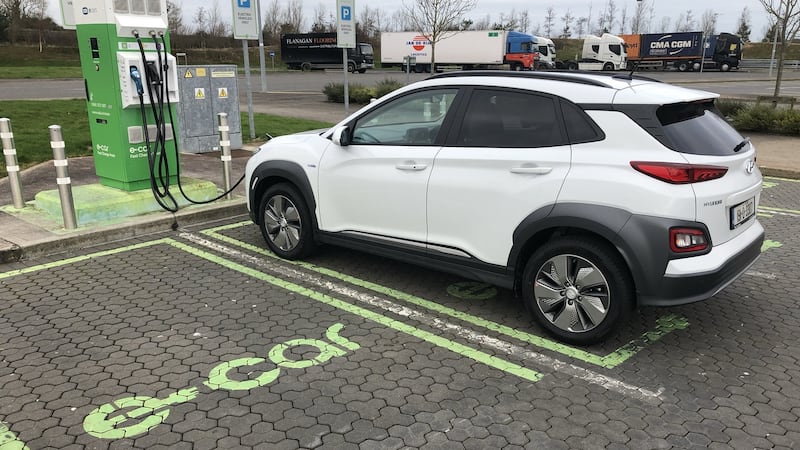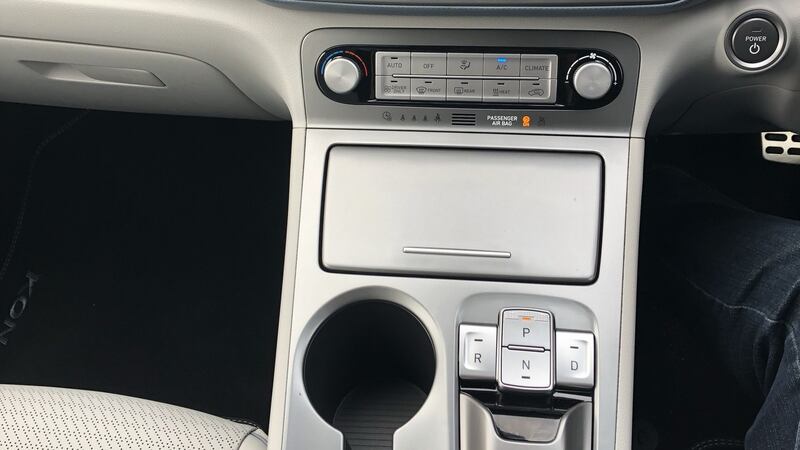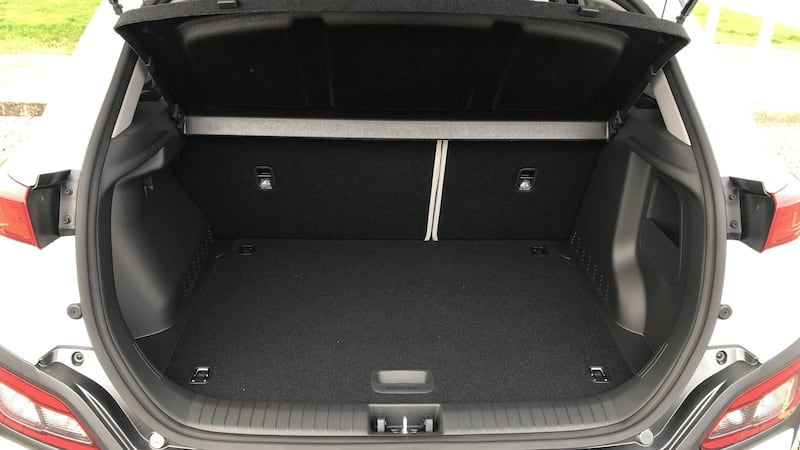Fresh off the boat from Korea, Hyundai’s Kona has already shot to the top of the Irish sales league for electric cars. The eco-friendly crossover has overtaken the Nissan Leaf over the first 20 days of 2019, which is a pretty momentous achievement given the Nissan’s well-established credentials.
Part of that can be ascribed to the looks – everyone seems to love a crossover these days. But the biggest lure is undoubtedly the range – a promise of up to 450km on a single charge puts it in the same ballpark as the Teslas. The American cars carry six-figure price tags, however, while the Kona costs from €37,630. Put those two ingredients together and you can see why Hyundai has a recipe for a sales success story.
The driving force behind this triumph is the addition of a new 64kWh battery pack. To put that into perspective, the Volkswagen e-Golf has a 35.8kWh battery, the latest Nissan Leaf has a 40kWh unit – with promises of a new 62kWh pack this summer – while the much-lauded Teslas range from 80.5kWh in the new Model 3 to a 100kWh pack available on the Model S.
The issue for electric car engineers is a bit like that facing the aviation world. You reach a point when designing aircraft when adding extra fuel to extend range adds so much weigh that most of the extra fuel is spent transporting the heavier fuel load. The story is mirrored in the development of electric car batteries to date, but as with the range of aircraft, strides are being made in the automotive world.
As we have witnessed in the last 20 years with mobile phones, battery technology is rapidly improving when it comes to cutting weight and power. Expect to see something similar with electric cars.
This does have a downside, of course, for the early adopters. The first generation of the Leaf back in 2012 was a revolution. But with a 24.5kWh battery and an ambitious official range of 175km, you can pick up a relatively low-mileage one from 2012 for €10,000. Even Teslas aren’t immune to the march of time and technology, and the consequent impact on resale values.
Back on the range with the Kona and we started out on a full charge with a promised of 444km before we would have to plug it into the grid. Over the next 169km of urban and suburban motoring the range dropped by 233km, thanks in part to my fondness for flooring the throttle. What’s impressive about that is only a few years ago that would have been a full charge on a high-end electric car. On the Kona I still had plenty left in the battery pack.
Expected range
Electric car evangelists regularly brag to me about their ability to exceed the stated expected range, thanks to a lightness of footwork worthy of a Strictly Come Dancing finalist. But for someone unaccustomed to the electric surge on a daily basis, I still find it hard to forgo the need for speed. The beauty of electric power is the immediate acceleration. A 0-100km/h time of 7.6 seconds is sporty for a small crossover – it's less than one second off the time for a VW Polo GTi and only a little slower than the lightening-fast Ford Fiesta ST.
Yet it delivers that speed with a certain grace. There are other electric cars that throw you back into the seat, but the Kona is less dramatic. Part of that is probably down to the fact it weighs in at about 1.7 tonnes. The biggest boon will always be jumping in and out of traffic when overtaking, rather than straight-line speed over a longer distance which devours the battery’s power.
Electric cars can sharply drop their range out on the motorway. Above 100km/h you really start to eat into battery power. For example, one 9km trip at motorway speeds – admittedly in sport mode – saw the expected range drop by 21km.

However, drivers can easily conserve the power. Keep your speed closer to 90km/h and you will find the predicted range is largely within reach. The electric Kona has a choice of drive settings from eco to sport, which includes an eco-plus option that limits speed to around 90km/h. Meanwhile, paddles on the steering wheel offer three levels of regenerative braking, the last of which does much the same as Nissan’s e-pedal in that it when you lift off the throttle the car slows quickly. Drive with a little forethought and you can manage with just the one pedal.
Apart from its range, the Kona has other strengths. For a start it’s a good looking car. Much like its arch rival, the Toyota C-HR, the relatively busy exterior styling has taken time to win us over, but both cars now look great out on the road.
The most obvious difference bewteen the electric version of the Kona and the petrol or diesel variants is the closed bodywork replacing the front grille.

Changes to the interior layout of the electric car are largely confined to the central console, which takes its styling cues from the gorgeous Hyundai Nexo, the Korean firm’s stylish crossover that’s sadly only offered with a hydrogen-fuel cell powertrain. These include a higher-set touchscreen system combined with a series of buttons in place of a gearstick or transmission dial. (Incidentally, if you haven’t come across the Nexo yet, then it’s worth looking it up. It’s the best looking car Hyundai has ever built.)
Weakest point
The interior is, however, also this car’s weakest point. It’s not an issue with build quality, which is on a par with rivals and arguably a little more refined in the electric version. The issue is space. At the end of the day this is a small hatchback, with rear-seat legroom and bootspace that is closer to a supermini than a family-sized SUV.
The boot can accommodate one large suitcase and a carry-on but that’s about it. If your life revolves around baby buggies and the usual accoutrements of the modern family then the Kona may not be for you and the larger Leaf may be a better option.
The electric Kona’s driving characteristics are largely the same as its standard-powered variants. The ride quality is comfortable, if a little firm, but the cornering is a little sharper, thanks to the electric version featuring a multi-link rear suspension, that washes out the worst of speed bumps and potholes.
And then there’s the price. Starting at €37,630, after all the various grants are taken into account, the extra range will set you back more than the 40kWh Leaf, which starts at €28,690.
Yet it’s the range that has been holding back many buyers and a realistic offering of late 300kms gives the Kona serious credibility even at this price. Typically to date you paid around €30,000 for an electric car that got you 150km or so, and anything that delivered the Kona’s distance between charges was in the €80,000 bracket or more.

This car changes the landscape, therefore. It’s basically offering the same range of a Tesla or Jaguar I-Pace at half the price. Others are set to follow with bigger batteries, including the Leaf with a 62kWh due this summer.
For now the Kona surges ahead of its rivals, delivering roughly twice the range of similarly priced rivals. That mix of real-world usage, good looks, and a reasonable price means this Hyundai is the rightful front-runner in the electric car market in the first few weeks of this year.
Lowdown: Hyundai Kona Electric
Power: 150kW electric motor powered from a 64kW battery pack. Delivers 395Nm of torque
0-100km/h: 7.6 seconds
Top speed: 167km/h
Range (official): 447km
Recharging time: 54 mins on a 100kW DC charger
Price: €37,630 (From €459 per month on PCP)
Motor tax: €120
Our rating: 4/5
Verdict: The first of a new generation of electric cars coming our way












